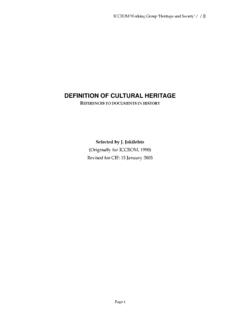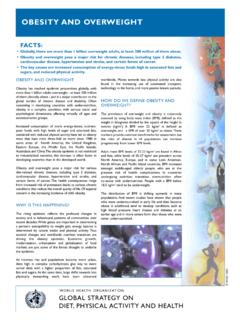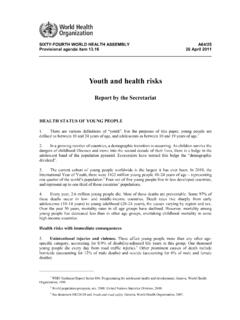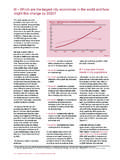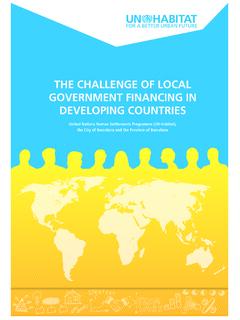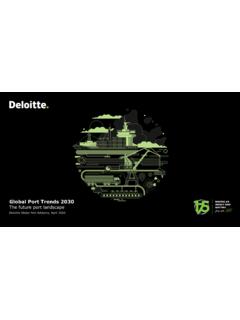Transcription of Rostow's stages of Economic growth - Weebly
1 MA/ MSSc 2016 Dr. G. M. Henegedara Session 4: University of Kelaniya Eon 53045 Session 5 Rostow's stages of Economic growth The Rostow's stages of Economic growth model is one of the liner Economic models of historic Economic growth . It was presented by American economist Walt Whitman rostow in 1960 as an alternative view of Marxist interpretation of history. Thus the model was recognized as political theory as well as descriptive Economic analysis of growth and development (Thirwall, 2006). rostow argued that Economic take-off must initially be led by a few individual sectors. This belief was based on the theory of comparative advantage presented by David Ricardo. He criticized Marxist revolutionary views on Economic transition.
2 This became one of the important concepts in the theory of modernization in social evaluation (Wikipedia, 2016) Rostow's model does not disagree with John Maynard Keynes regarding the importance of government control over domestic development which is not generally accepted by some ardent free trade advocates. The basic assumption given of rostow s theory is that countries want to modernize and grow and that society will agree to the materialistic norms of Economic growth . Thus rostow s thesis has identified five stages of Economic development according historic Economic performance of developed countries. 1. Traditional society 2. Preconditions for self-sustaining growth 3. Take-off 4. Drive to maturity 5. The stage of High mass consumption 1. Traditional society Traditional societies are characterized by nature and limitation of technology.
3 Thus more than 75 percent of labour force is occupied in agricultural activities. Low Social mobility and great division of wealth and political power were recognized as other main features. Wars, famines and epidemics like plague cause initially expanding populations to halt or shrink, limiting the single greatest factor of production: human manual labor. Volume fluctuations in trade due to political instability are frequent; historically, trading was subject to great risk and transport of goods and raw materials was expensive, difficult, slow and unreliable. The manufacturing sector and other industries have a tendency to grow but are limited by inadequate scientific knowledge and a "backward" or highly traditionalist frame of mind which contributes to low labour productivity.
4 In this stage, some regions are entirely self-sufficient. MA/ MSSc 2016 Dr. G. M. Henegedara Session 4: University of Kelaniya Eon 53045 In settled agricultural societies before the Industrial Revolution, a hierarchical social structure relied on near-absolute reverence for tradition, and an insistence on obedience and submission. This resulted in concentration of political power in the hands of landowners in most cases; everywhere, family and lineage, and marriage ties, constituted the primary social organization, along with religious customs, and the state only rarely interacted with local populations and in limited spheres of life. This social structure was generally feudalistic in nature.
5 Under modern conditions, these characteristics have been modified by outside influences, but the least developed regions and societies fit this description quite accurately. Thus it is characterized by subsistence agriculture or hunting and gathering; almost wholly a "primary" sector economy Limited technology A static or 'rigid' society: lack of class or individual Economic mobility, with stability prioritized and change seen negatively 2. Pre-conditions for self-sustaining growth According to rostow , pre-condition of takeoff were characterized by change in political and social transition from feudalism (Thirwall, 2006). Thus the stage between feudalism and takeoff is called as transitional stage. The main Economic requirement in the transition phase is the level of investment should be increased at least to 5- 10 percent of national income to ensure self-sustaining growth .
6 The main direction of investment is for developing physical and social infrastructure transport. There are three important dimensions to this transition: firstly, the shift from an agrarian to an industrial or manufacturing society begins, albeit slowly. Secondly, trade and other commercial activities of the nation broaden the market's reach not only to neighboring areas but also to far-flung regions, creating international markets. Lastly, the surplus attained should not be wasted on the conspicuous consumption of the land owners or the state, but should be spent on the development of industries, infrastructure and thereby prepare for self-sustained growth of the economy later on. Furthermore, agriculture becomes commercialized and mechanized via technological advancement; shifts increasingly towards cash or export-oriented crops; and there is a growth of agricultural entrepreneurship.
7 The strategic factor is that investment level should be above 5% of the national income. This rise in investment rate depends on many sectors of the economy. According to rostow capital formation depends on the productivity of agriculture and the creation of social overhead capital. Agriculture plays a very important role in this transition process as the surplus quantity of the produce is to be utilized to support an increasing urban population of workers and also becomes a major exporting sector, earning foreign exchange for continued development and capital formation. Increases in agricultural productivity also lead to expansion of the domestic markets for manufactured goods and processed commodities, which adds to the growth of investment in the industrial sector. Social overhead capital creation can only be undertaken by government, in Rostow's view.
8 Government plays the driving role in development of social overhead capital as it is rarely profitable, it has a long gestation period, and the pay-offs accrue to all Economic sectors, not primarily to the investing entity; thus the private sector is not interested in playing a major role in its development. On the social front, a new elites must emerge to construct the industrial society and it must be superseded authority of land based elites of the traditional society. Surpluses must be channeled by new MA/ MSSc 2016 Dr. G. M. Henegedara Session 4: University of Kelaniya Eon 53045 elites from agriculture to industry (Thirwall, 2006). In summary, the country would be able to achieve following requirements at this stage.
9 Develop social infrastructure such as transport, irrigation and communication Increase food production sufficiently to feed population Increase imports while increasing capital goods and expanding entrepreneurial activities All these changes effectively prepare the way for "take-off" only if there is basic change in attitude of society towards risk taking, changes in working environment, and openness to change in social and political organizations and structures. The pre-conditions of take-off closely track the historic stages of the (initially) British Industrial Revolution. 2. Take off The characteristics of takeoff is sometimes difficult to distinguish from the stage of pre-condition to take off. However, since the pre condones for the takeoff have been met in the transition stage, take off is a short stage of development that takes nearly two decades.
10 Development become self-sustaining and investment must rise exceeding 10 percent of national income so as to increase per capita income and level of investment. According to historical records, domestic finance for takeoff has fulfilled through two main sources agricultural taxes, rents (Meiji reforms, Japan, and voluntary investment by land lords. According to rostow there are three main requirements for take-off: 1. "The rate of productive investment should rise from approximately 5% to over 10% of national income or net national product 2. The development of one or more substantial manufacturing sectors, with a high rate of growth ; 3. The existence or quick emergence of a political, social and institutional framework which exploits the impulses to expansion in the modern sector and the potential external economy effects of the take-off" , the needed capital is mobilized from domestic resources and is steered into the economy and not into domestic or state consumption.)
